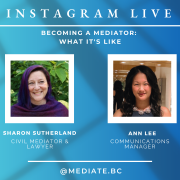Tue 19 May 2015
On Co-Mediation Part II
Posted by Nick.deDomenico
In Part I, I expanded upon how the applicant (Ms Sainty) and I saw benefits in our partnership, confirmed our pairing and began the process of working with mediation parties in seeking their permission to proceed with a co-mediation model.
Below, I would like to continue and expand upon the co-mediation structure we employed, and the benefits, as I see them, of our co-mediation approach.
Our Co-Mediation Structure (or Process)
Observation status provided the applicant with an upfront and personal view of the professional world that I live in without the pressure of taking on any responsibility for the outcome.
It allowed us both the opportunity to confirm, or reverse our decision to engage and gave us both the opportunity to set up the mechanics of a working relationship.
After three ‘observation’ mediations we began, over the next ten mediations, to gradually increase the applicant’s active role in the process as a co-mediator.
Once the applicant was accepted as co-mediator on a given file, I would send the applicant the confirmation note listing time and place and persons involved together with the briefs from the plaintiff(s) and defendant(s).
That was followed by a half hour meeting at the mediation location ahead of the arrival of any of the other participants. Here we exchanged impressions, identified issues and considered a general approach.
During the mediation, we would have ongoing chats, exchanging ideas and perspectives as the matter evolved. Immediately following the mediation we would debrief for a half hour or so.
The Benefits of Co-Mediating at the Table
That whole process took about five months. Ms Sainty has submitted her application and has recently been accepted to the Civil Mediator Roster at the time of this writing. I am confident that she will be a valuable addition to the Roster and will effectively promote the idea of mediation within the litigation community, to the benefit of us all in the future. There are however more specific benefits for all involved that I will comment on briefly in the remaining paragraphs of this article.
This structure provided a source of candid feedback from the applicant on my own actions. While Ms. Sainty was new to role of mediator she comes to this process as a very experienced lawyer and recently retired member of the judiciary so her observations, opinions and questions, focused as they were in large part on my role as mediator, were of great value to me.
In the future, she will, where appropriate, introduce me as co-mediator to her clients, using a similar process. This will provide me with paid work I would not otherwise get and allow me to recoup the portion of fees that I shared with Ms. Sainty in her fulfillment of her paid mediation requirement.
Further, supported by Ms. Sainty’s experience and knowledge, I will in turn be provided with the opportunity to gain experience mediating in areas of law I have not previously worked in.
From the clients’ perspective, during these thirteen mediations, our ongoing dialogue helped maintain a higher level of objectivity and a wider range of options than I believe would have been available were I working in isolation.
Finally, both Ms. Sainty’s clients and my own may benefit in the future in that they will have a safe introduction to an alternate mediator that they can turn to in situations where their first choice may not be available on a preferred date.
I’ll end on a turn of the classic phrase, for new mediators generally or to specific areas of law, to established mediators, to lawyers looking for broadening their reliable service provider base, and for clients working with counsel within the mediation process, co-mediation in the context of ‘new’ mediators is definitely a win-win-win-win.
Find out more about Nick's co-mediator, Kathryn Sainty.
Part III of the "On Co-Mediation" series is written from the perspective of a Family Roster mediator and lead-mediator in the Mediate BC Family Mediation Program.
Introduction | Part I | Part II | Part III | Part IV | Part V | Part VI | Part VII
 Today's guest blogger is Nick de Domenico, a Mediate BC Civil Roster mediator whose mediation practice focuses largely on personal injury and is a member of the Mediate BC Roster Committee. Nick keeps a busy civil mediation practice in the Greater Vancouver area, njd.ca.
Today's guest blogger is Nick de Domenico, a Mediate BC Civil Roster mediator whose mediation practice focuses largely on personal injury and is a member of the Mediate BC Roster Committee. Nick keeps a busy civil mediation practice in the Greater Vancouver area, njd.ca.
[Editor's note: Many of the posts in this series refer to the personal experiences of the author. When considering applying to a Mediate BC Roster, please be sure to review the requirements at mediatebc.com.]




